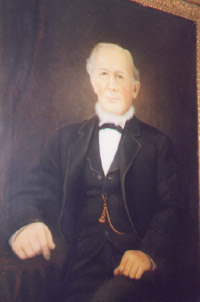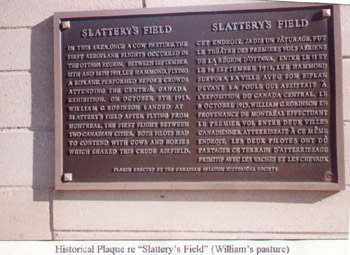|
Becoming established in Ottawa
 William
was the oldest of the children of Patrick and Bridget
of whom we have a record. He was born in Ireland on
March 5, 1820, according to the inscription at the family
plot which lists his death as August 12, 1885 at age
65, 5 months and 7 days. He is described as a native
of Limerick. It is interesting however, that the obituary
of his son Bernard says that his father was a native
of County Kilkenny. Possibly he worked there before
emigrating. William
was the oldest of the children of Patrick and Bridget
of whom we have a record. He was born in Ireland on
March 5, 1820, according to the inscription at the family
plot which lists his death as August 12, 1885 at age
65, 5 months and 7 days. He is described as a native
of Limerick. It is interesting however, that the obituary
of his son Bernard says that his father was a native
of County Kilkenny. Possibly he worked there before
emigrating.
William married Honorah McGrath on April
4, 1850 at Notre Dame Cathedral in Ottawa. William was
30 and she was 23. She too was born in Ireland. The
marriage date shows that he emigrated before 1850, and
probably after 1845 with his father and other family
members. Further evidence is found in an article in
the Ottawa Citizen in 1879, which reported favourably
on William's butcher business, which began in the Bytown
market. The article reports that he had been doing business
in Ottawa "for over 30 years". He probably
began his career as a butcher in Ireland under his father's
tutelage.
The By-Ward Market was established very
early in the development of Bytown. A Market Building
had been built on George Street, and across the street
a large butchering and meat packing industry was developed
between 1830-1840, which became known as "The Butcher's
Shambles". (Shambes is an old name for a butcher's
slaughter house.) This is where William would have started
his career.
On Feb. 21, 1851, Bridget was born to
William and Honorah, as duly recorded at Notre Dame
Cathedral. That year William leased Lot 19 on the north
side of Clarence Street. However, it was apparently
not for housing, as it was left vacant until 1858. Probably
he used it for grazing of animals to be slaughtered.
The first census of Bytown, nominally
1851, had an effective date of Jan. 11, 1852. William
is listed therein as a butcher. With him was his wife
Honorah, daughter Bridget, his brother Myles, and a
maid aged 14. They were living in a 11/2 story log house
with land attached, and they had three pigs, but the
house location was not given. In other 1852 records
William was listed as one of those petitioning to have
the open drain on Clarence St. covered over.
On Aug 8, 1852, Bernard was born. He was
destined, in due course, to become very prominent in
Ottawa. Then in July 1855, twins Anastasia and John
were born but lived only one day. Honorah died before
1858, when William remarried. It seems probable that
her untimely death may have resulted from the birth
of the twins. At this time her date of death and burial
place have not been found.
William married Margaret Hendrick on Feb.
9, 1858 at Notre Dame Cathedral. Like Honorah, Margaret
was born in Ireland That year William built a 1 1/2
story clapboard house for his family on the west half
of his Clarence St. lot, which at that date had a street
address of 135 Clarence St.
Up to this point, neither William or Myles
were listed in the Ottawa City Directory which had been
published yearly from 1850. However in 1861, they were
both listed, in separate houses on Clarence St., William
as a butcher but no occupation listed for Myles. The
1861 Census lists Myles as a grocer living in a two
story frame house, but unaccountably does not list William.
Changing Residences
By 1862 William had made another significant investment
in building a large double house on the east half of
Lot 19, listed as 137-139 Clarence St., but it appears
that he did not live there. It was occupied by tenants
until 1900 when it was sold by his family. On the other
hand, in 1866, William was living at 118 Clarence Street,
a new address on the south side of Clarence St. He lived
there until 1875.
William and Margaret had eleven children,
including an infant who died soon after birth. In 1873
they had a very full household living in the house on
Clarence St. A bigger house and more land for raising
cattle were sorely needed. Consequently, in 1873 William
purchased a 27 acre property in what later became Ottawa
East.
The new property was roughly triangular
in shape extending along the Rideau River, from east
of present day Main Street to Clegg Street. It was legally
described as Lot K, concession D, Nepean Township. At
that tie, Main Street was called the Gloucester Road
or the more elegant sounding Spring Park Road. In the
City Directory it was in the village of Archville, which
later became Ottawa East. Beside pasturage, he built
a smoke house and an abattoir on the property, and not
least he built a large home for his family. The house
has been described as of wood construction with gingerbread
trim. It was destroyed by fire in the 1890's.
Back
to top
The Butchering
Business
In the 1861 City Directory, William's shop was described
only as on Clarence Street. In January 1862, much of
the market area was destroyed by fire. There were eight
butchers at that time. Five of them lost most of their
meat and William was one of them. The other three suffered
little loss. There is no evidence that William's location
had changed but the directory became more specific as
the years went by, until in 1864 his shop was described
as "Stall 5, outside, Old Market Building".
Table 3
summarizes the growth of William's meat business
 In
the earlier Bytown days, town meetings were held on
the second floor of the old Market Building. In 1865
a new Market Building of stone construction was built,
but at first the butchers preferred the older one. Over
the years there were many fires and many losses. In
spite of these problems, William's goods were attracting
favourable comment. In 1876, his introduction of Western
beef was highlighted, and also his spring lambs and
mutton fed by himself on his new property at Spring
Park. The photo shows the new Market Building in the
late 1800's. In
the earlier Bytown days, town meetings were held on
the second floor of the old Market Building. In 1865
a new Market Building of stone construction was built,
but at first the butchers preferred the older one. Over
the years there were many fires and many losses. In
spite of these problems, William's goods were attracting
favourable comment. In 1876, his introduction of Western
beef was highlighted, and also his spring lambs and
mutton fed by himself on his new property at Spring
Park. The photo shows the new Market Building in the
late 1800's.
The butchers were important merchants
in Lower Town. Newspapers of the day describe how the
Butchers' Ball in 1877 was the best ever. William was
one of the sponsors, and his son Bernard (then 25) had
a very active role in the affair.
When Bytown was first founded, Lower Town
was planned to house the workers and their shops, while
the gentry were to live in Upper Town on the higher
ground across the canal. However, Lower Town grew and
prospered at the expense of Upper town. The citizens
of Upper Town demanded their own market place. Accordingly
the Wellington Ward Market was established in the vicinity
of present-day Wellington and Lyon Streets. William
grasped an opportunity to expand and he established
a shop there (Stall 6) in 1876. His son Bernard married
in 1879 and William turned over the Wellington shop
to him. His other sons, William and Michael, then 20
and 18 respectively were no doubt working in the two
shops.
In 1877, William expanded his land holdings
again. He purchased a large acreage on the west side
of Gloucester road (Main Street). It was bordered on
the north by Clegg Street, on the east by Gloucester
road, and on the south by Riverdale Avenue. The northerly
part, which was kept as a pasturage for many years,
became known as "Slattery's Field".
In addition, that same year, he also purchased nearly
50 acres of land, Lots 21-25, in Gloucester Township,
in the vicinity of present-day Cyrville. This could
have been for investment purposes or to provide more
pasturage for the animals needed for his expanding meat
business.
The following stories concerning "Slattery's
Field" are derived from newspaper accounts. First,
in 1911, Slattery's Field made the newspapers of the
day as the site of the first airplane flights in the
Ottawa region, only eight years after the Wright brother
first "took to the air" in the United States. An American, Lee Hammond, during several days in September,
flying a biplane, made short demonstration flights from
Slattery's field over the Central Canada Exhibition
t Lansdowne Park. His flights came to an abrupt end
while trying to land. A herd of cows got in his way,
and his plane was damaged trying to avoid them.
An American, Lee Hammond, during several days in September,
flying a biplane, made short demonstration flights from
Slattery's field over the Central Canada Exhibition
t Lansdowne Park. His flights came to an abrupt end
while trying to land. A herd of cows got in his way,
and his plane was damaged trying to avoid them.
The next claim to fame for Slattery's
Field occurred in October 1913 when the newly launched
Montreal Daily Star commissioned William Robinson to
fly copies of their first papers to Ottawa. Because
of mechanical problems, the plane had to land five times
enroute to Ottawa! Eventually he was ready to land at
Lansdowne Park but couldn't because of a large crowd
of spectators. He was able to land instead at Slattery's
Field. The next day he attempted a demonstration flight
but his engine failed and he crashed at the corner of
Clegg and Drummond Sts. The plane was totaled but he
was unhurt. In spite of the mishaps, this was the first
flight between two cities in Canada.
The highlight of William's career occurred
in 1879 when he was honoured by acquiring the much-coveted
Vice Regal patronage for his meat. A new awning now
graced his ByWard shop, reading " William Slattery,
purveyor to his excellency the Governor General ".
Back
to top
The Final Years
William died August 12, 1885, age 66, at Caledonia Springs,
Prescott County. This was the location of a "spa",
which had been established by an enterprising local
farmer at a spring on his property. The Caledonia springs
Hotel was already advertising in the Bytown Gazette
in 1836. William was probably there for treatment when
he died. He did not live to see the major expansion
of his butcher shops under his son Bernard, but he did
leave a well-established and highly regarded business
to his family.
William did not have a will, which suggests
that he died unexpectedly. The court awarded his personal
estate to his widow Margaret, apart from a $6000 balance
placed in trust with the court, presumably for his children.
The trustees evidently divided his business and real
estate assets in equal parts to his nine surviving children.
Margaret sold the property to Bernard who used a go-between
to represent him. (There could be a story in this.)
In June 1890 Margaret died, only 56 years
of age. She was buried with William in Notre Dame Cemetery.
|